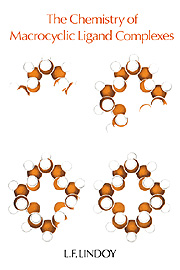Book contents
- Frontmatter
- Contents
- Preface
- 1 What is different about macrocyclic ligand complexes?
- 2 Synthetic procedures
- 3 Macrocyclic systems – some further categories
- 4 The metal-ion chemistry of polyether and related macrocyclic systems
- 5 Host-guest chemistry: macrocyclic hosts and non-metallic guests
- 6 Thermodynamic considerations
- 7 Kinetic and mechanistic considerations
- 8 Redox properties
- 9 The natural macrocycles
- References
- Index
1 - What is different about macrocyclic ligand complexes?
Published online by Cambridge University Press: 08 October 2009
- Frontmatter
- Contents
- Preface
- 1 What is different about macrocyclic ligand complexes?
- 2 Synthetic procedures
- 3 Macrocyclic systems – some further categories
- 4 The metal-ion chemistry of polyether and related macrocyclic systems
- 5 Host-guest chemistry: macrocyclic hosts and non-metallic guests
- 6 Thermodynamic considerations
- 7 Kinetic and mechanistic considerations
- 8 Redox properties
- 9 The natural macrocycles
- References
- Index
Summary
Background
The understanding of the metal-ion chemistry of macrocyclic ligands has important implications for a range of chemical and biochemical areas. Macrocyclic ligands are polydentate ligands containing their donor atoms either incorporated in or, less commonly, attached to a cyclic backbone. As usually defined, macrocyclic ligands contain at least three donor atoms and the macrocyclic ring should consist of a minimum of nine atoms. The metal-ion chemistry of macrocyclic ligands has now become a major subdivision of inorganic chemistry and undoubtedly great interest in this area will continue in the future.
A very large number of synthetic, as well as many natural, macrocycles have now been studied in considerable depth. A major thrust of many of these studies has been to investigate the unusual properties frequently associated with cyclic ligand complexes. In particular, the investigation of spectral, electrochemical, structural, kinetic, and thermodynamic aspects of macrocyclic complex formation have all received considerable attention.
The fact that macrocyclic ligand complexes are involved in a number of fundamental biological systems has long been recognized. The importance of such complexes, for example to the mechanism of photosynthesis, or to the transport of oxygen in mammalian and other respiratory systems, has provided a motivation for investigation of the metal-ion chemistry of these systems as well as of cyclic ligand systems in general. The possibility of using synthetic macrocycles as models for the biological systems has provided an impetus for much of this research.
- Type
- Chapter
- Information
- The Chemistry of Macrocyclic Ligand Complexes , pp. 1 - 20Publisher: Cambridge University PressPrint publication year: 1989
- 1
- Cited by



